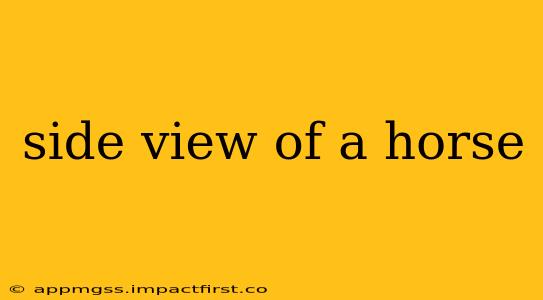The side view of a horse, often called a profile, offers a unique opportunity to capture its power, grace, and athleticism. This perspective highlights the animal's muscular structure, elegant lines, and overall conformation. Whether you're a professional photographer or an enthusiastic amateur, understanding the key elements of capturing a stunning side-view horse photograph is crucial. This guide will equip you with the knowledge and techniques to produce captivating images that truly showcase the beauty of these magnificent creatures.
What Makes a Great Side View Horse Photograph?
A truly exceptional side-view horse photograph goes beyond simply capturing the animal's profile. Several factors contribute to a compelling image:
-
Sharp Focus: Crystal-clear focus on the horse's eye is paramount. A sharp eye draws the viewer in and adds life to the image. Blurry images, on the other hand, lack impact and diminish the overall quality.
-
Proper Lighting: The lighting conditions significantly impact the mood and visual appeal of the photograph. Soft, diffused light often produces the most flattering results, minimizing harsh shadows and highlighting the horse's features. Avoid harsh midday sun, which can create unflattering contrast and squint in the horse's eyes.
-
Composition: Consider the rule of thirds, placing the horse off-center to create a more visually engaging composition. Leaving space in front of the horse allows for a sense of movement and anticipation.
-
Background: A clean, uncluttered background helps the horse stand out as the focal point. Busy backgrounds can distract from the subject and detract from the overall impact of the photograph.
-
Pose and Movement: A slightly posed horse can look more elegant and controlled, but capturing natural movement can add dynamism and energy to the image. Experiment with different poses and speeds to achieve desired results.
What Equipment Do I Need?
While you can achieve great results with a smartphone, professional-grade equipment will offer more control and flexibility:
-
Camera: A DSLR or mirrorless camera provides superior image quality and control over settings like aperture, shutter speed, and ISO.
-
Lens: A telephoto lens is ideal for capturing horses from a distance, minimizing disruption and allowing for a more natural pose. A longer lens (e.g., 70-200mm or longer) will give you the ability to compress the perspective and create a more dramatic image.
-
Tripod: A tripod is beneficial for sharper images, especially in low-light situations or when using slower shutter speeds.
-
Remote Shutter Release: This helps avoid camera shake when taking photos, ensuring crisp, clear images.
How Can I Get the Horse to Pose for a Side Profile Shot?
Getting the perfect side-view shot often requires patience and understanding of equine behavior. Here are some helpful tips:
-
Patience is Key: Horses are not always cooperative. Be patient and let the horse settle into a relaxed pose.
-
Positive Reinforcement: Use treats or gentle verbal encouragement to guide the horse into the desired position. Never force the animal.
-
Work with the Handler: If possible, collaborate with a handler experienced in posing horses.
-
Capture Natural Moments: Don't be afraid to capture natural moments between poses. These candid shots can be equally compelling.
What are Some Common Mistakes to Avoid?
-
Poor Focus: Ensure the horse's eye is in sharp focus.
-
Harsh Lighting: Avoid midday sun and use diffusers if necessary.
-
Cluttered Background: Choose a clean background to highlight the horse.
-
Poor Composition: Utilize the rule of thirds for a more engaging image.
-
Camera Shake: Use a tripod or a fast shutter speed to avoid blurry images.
By following these guidelines and practicing patience, you'll be well on your way to capturing stunning side-view photographs of horses that showcase their majestic beauty and unique characteristics. Remember, the most important aspect is capturing the essence of the horse; the rest will follow.
